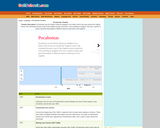
This timeline outlinesthe life of Pocahontas, the Native American daughter of an Indian chief near the Virginia Colony.
- Subject:
- Social Studies
- Material Type:
- Reading
- Provider:
- SoftSchools.com
- Date Added:
- 02/17/2017

This timeline outlinesthe life of Pocahontas, the Native American daughter of an Indian chief near the Virginia Colony.

This is a remix of Historical Figures Research Project / Wax Museum by Lisa VanOmmen.This remix focuses on second grade standards. It takes the learner through a series of lessons so they understand a timeline, the correct sequence of events, and how timelines are important when learning about historical figures.

This interactive resource explains how timelines are constructed and used to document historical events.

In this activity, students collectively construct an illustrated timeline of historic events and people they have studied.

The lesson looks more closely at how scientific and technological innovations have changed the way people meet their needs in communities. Robert Fulton is used as an example of an innovator in this lesson that focuses on changes in transportation.
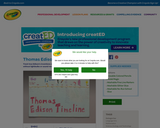
Students track how Edison's inventions changed everyday life and imagine a world without lightbulbs or sound recordings.
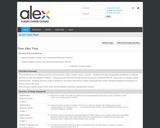
This unit will focus on ordering common events by times, days, months, steps, or events. Students will utilize biographies and books on national symbols to read and interpret timelines. Groups will use historical text and primary sources to create timelines by using rulers to measure equal-spaced points. Students will also create a timeline to reconstruct the history of their school staff and create individual timelines to reconstruct a history of their own past.

This lesson will focus on ordering common events by times, days, months, steps, or events. Students will work collaboratively in groups to organize five child-focused events, steps, or times. These titles, events, steps, days, and times will be cut apart so that students need to organize them into a logical sequence. Groups will rotate through the five events to practice daily schedules, holidays, school schedules, weekly events, and procedural texts. Groups may take a picture of completed events as a digital copy or the teacher may check each group for formative assessment.
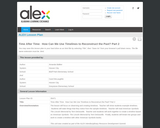
This lesson will focus on observing and creating timelines. Teacher will show students example timelines. Students will state things that they notice from the sample timelines. Teacher will read American Symbols: The Lincoln Memorial by Terri DeGezelle. Teacher and students will work together to create a timeline based on American Symbols: The Lincoln Memorial by Terri DeGezelle. Finally, students will break into groups and work to create a timeline with other American Symbols books.
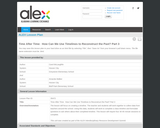
This lesson will focus on creating a timeline. The teacher and students will work together to collect data from teachers around the school. Using this data, students will work to complete a class timeline and formulate questions to ask others about their completed timeline. This lesson will require four 30-45 minute sessions to complete.
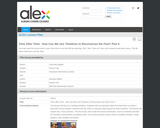
This lesson will focus on creating timelines. Students will use important dates from their lives to create a personal 5 event timeline. Students will use rulers to measure equal spaces for their timelines. This lesson will require two 1 hour sessions. The first session will include the lesson introduction, work on timelines and time for formative assessments as students work. The second session will be used to complete timelines, share projects, and complete exit tickets.

Students will be able to explain what a timeline is and how it can be used to describe two American time periods: colonial and present day.
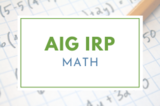
Students will construct a timeline using a meter stick to help them draw precise divisions. They will choose a topic they have been studying. After making the timeline, the students will use the information to make up problems using sums and differences and use the timeline as a number line to solve the problems. This lesson was developed by NCDPI as part of the Academically and/or Intellectually Gifted Instructional Resources Project. This lesson plan has been vetted at the state level for standards alignment, AIG focus, and content accuracy.
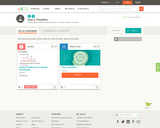
This short video and interactive assessment activity is designed to teach second graders about using timelines to 1-minute increments.
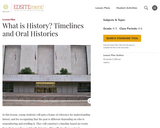
This lesson plan addresses the ways people learn about events from the past and discusses how historical accounts are influenced by the perspective of the person giving the account. To understand that history is made up of many people's stories of the past, students interview family members about the same event and compare the ifferent versions, construct a personal history timeline and connect it to larger historical events, and synthesize eyewitness testimony from different sources to create their own "official" account.